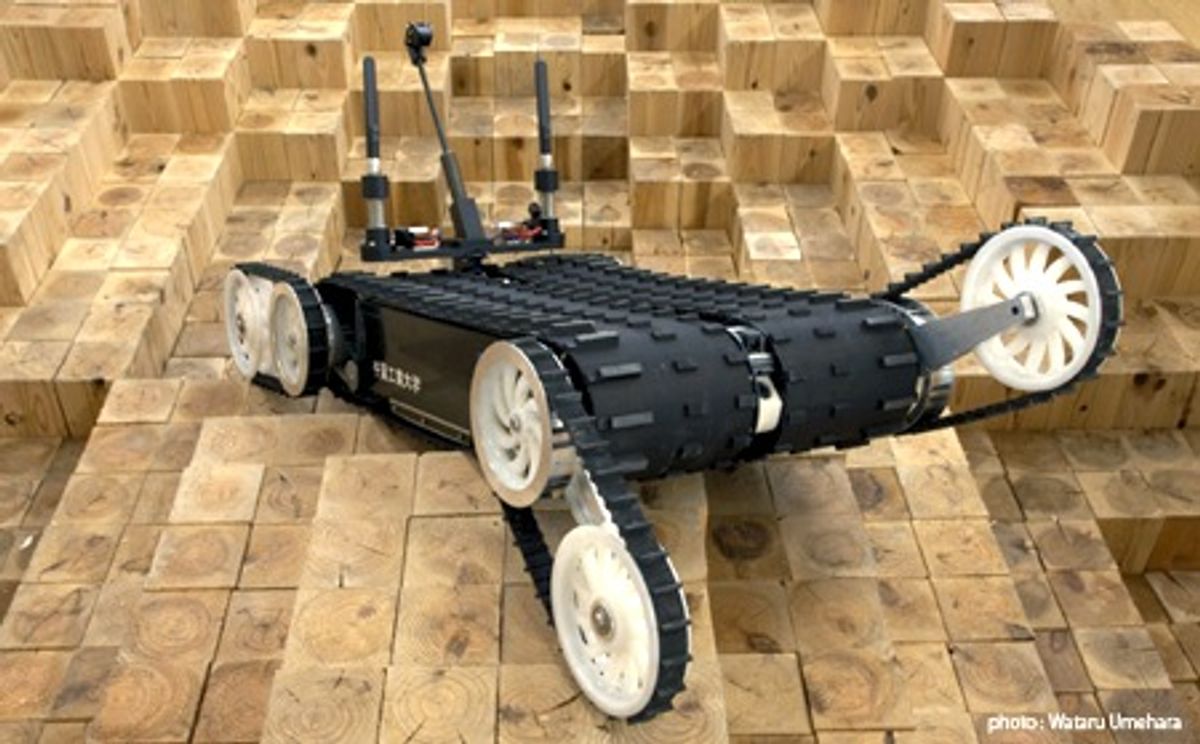Editor’s Note: This is part of our ongoing news coverage of Japan’s earthquake and nuclear emergency.
Japan’s earthquake will be a major test for search-and-rescue robots like Quince, developed by Chiba Institute of Technology roboticists, shown here during a demonstration.
Japan’s leading experts in rescue robotics are deploying wheeled and snake-like robots to assist emergency responders in the search for survivors of the devastating earthquake and tsunami that struck the country last Friday.
Details are still scarce, but I’ve gotten word that at least two teams plan to use their search and rescue robots, one team in Tokyo and another in or around Sendai, the city that suffered the most damage in the 8.9 magnitude earthquake and ensuing tsunami. I’m waiting confirmation about a third team, also in Tokyo. (There is no information about the presence of robots at Japan’s troubled Fukushima nuclear power plants, though that would be an ideal application for teleoperated repair and inspection robots.)
Dr. Robin Murphy, director of the Center for Robot-Assisted Search and Rescue (CRASAR) at Texas A&M University, in College Station, and one of the world’s top experts in rescue robotics, confirms that a team led by Satoshi Tadokoro of Tohoku University, in Sendai, and a team led by Eiji Koyanagi from Chiba Institute of Technology’s Future Robotics Technology Center, have deployed, or are about to deploy, their robots.
She reports that Dr. Tadokoro is “en route” to Sendai, where he lives, with the Active Scope Camera, a remote operated 8-meter-long snake-like robot that carries a scope camera and can slither through small spaces. According to Dr. Murphy, it’s “possibly the most capable robot for tight spaces.” At the same time, Dr. Koyanagi will use an agile robot called Quince, which has tank-like tracks and is capable of driving over rubble and climbing stairs, around his home area in Tokyo.
Here’s a video of the Active Scope Camera:
Here’s a video of Quince:
Dr. Murphy, an IEEE Fellow whose team has taken robots to disaster sites like the World Trade Center after the September 11, 2001 attacks and New Orleans after hurricane Katrina, tells me that robots have been used in at least one previous earthquake, the 2010 Haiti disaster. The U.S. Army Corps of Engineers, she says, used a SeaBotix underwater remotely operated vehicle, or ROV, to investigate bridge and seawall damage as part of the U.S. assistance to the Haitian government.
For a disaster like the Japan quake, she says several types of robots could prove useful, including:
• small unmanned aerial vehicles like robotic helicopters and quadrotors for inspection of upper levels of buildings and lower altitude checks
• snake robots capable of entering collapsed buildings and slithering through rubble
• small underwater ROVs for bridge inspection and underwater recovery
• tether-based unmanned ground vehicles like sensor-packed wheeled robots that operators can drive remotely to search for survivors
As it happened, Japan’s leading rescue robotics experts, a cadre led by Dr. Tadokoro, who heads the International Rescue Systems Institute, were actually in the United States when the earthquake hit! The 21 faculty and students and their rescue robots were in Texas participating in an exercise and workshop that CRASAR organized. The group headed back to Japan on Friday as soon as they heard the news.
Dr. Murphy, who leads the volunteer search-and-rescue robotics group Roboticists Without Borders, part of CRASAR, says the Japanese welcomed her group’s assistance; she’s now on standby awaiting a formal request. CRASAR’s robotic arsenal includes the AirRobot and iSensys helicopters, a VideoRay ROV for underwater inspection, a AEOS water vehicle with a sonar suited for bridge inspection, and several ground robots like the Inuktun VGTV, a tracked vehicle that can change its shape.
Quince is a mobile robot equipped with four sets of tracked wheels, some of which can move up and down to allow the robot to negotiate obstacles. It carries cameras as well as infrared and carbon-dioxide sensors for detecting the presence of survivors trapped under rubble.
Our thoughts go to the Japanese people affected by this tragedy. We hope emergency personnel can locate all survivors as fast as possible—and if robots can help, great.
Image: Chiba Institute of Technology; videos: DigInfo and Chiba Institute of Technology
Erico Guizzo is the Director of Digital Innovation at IEEE Spectrum, and cofounder of the IEEE Robots Guide, an award-winning interactive site about robotics. He oversees the operation, integration, and new feature development for all digital properties and platforms, including the Spectrum website, newsletters, CMS, editorial workflow systems, and analytics and AI tools. An IEEE Member, he is an electrical engineer by training and has a master’s degree in science writing from MIT.





